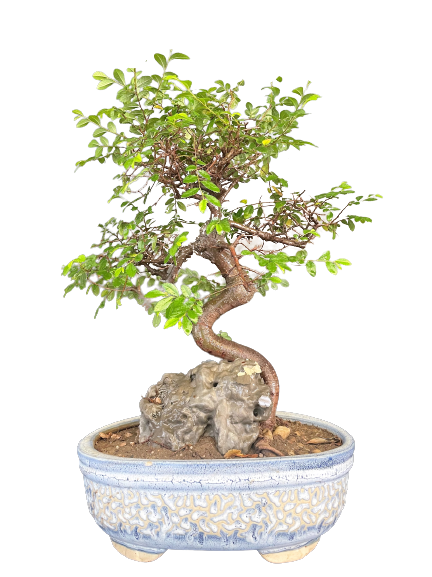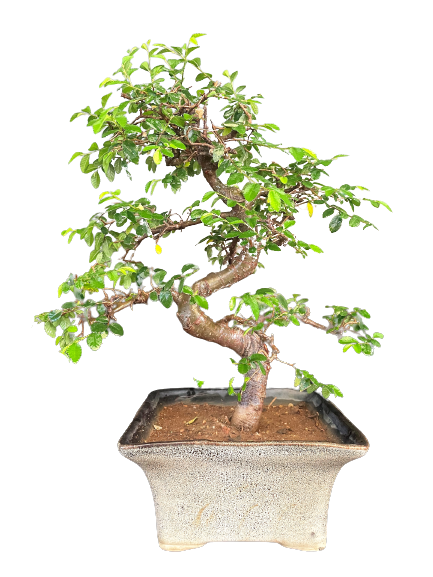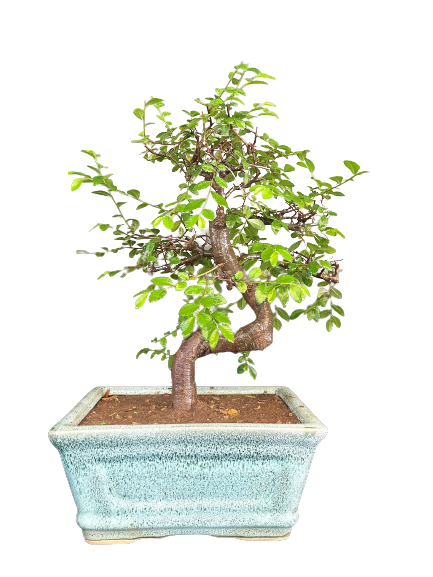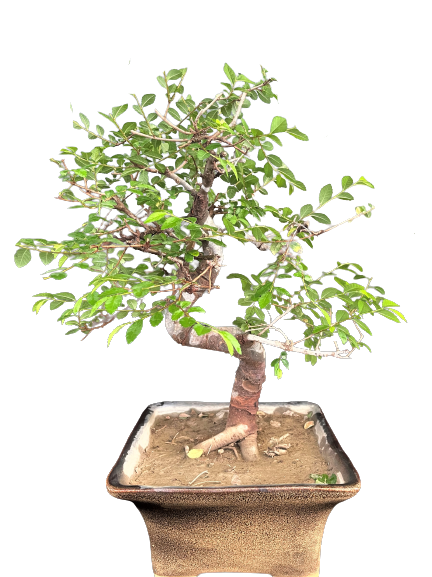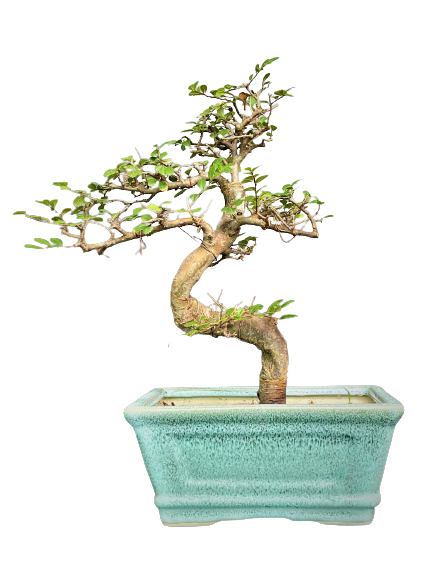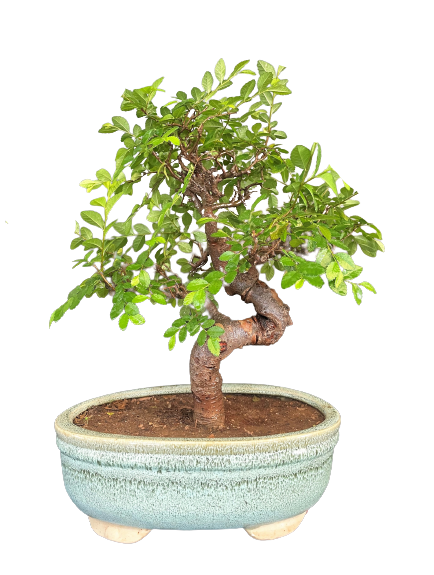
Chinese Elm Bonsai
A Perfect Bonsai Tree Species for Delhi’s Climate
Bonsai trees are a popular way to add beauty and nature to any indoor or outdoor space. One of the most versatile and adaptable bonsai tree species is the Chinese Elm. In this article, we will explore why the Chinese Elm bonsai is a perfect bonsai tree species for Delhi’s climate.
Introducing the robust and easy-to-maintain hardy plant that is perfect for balconies, gardens, and indoor spaces with ample natural light. This plant boasts a real woody bonsai structure with a thick trunk, making it a delightful addition to any collection. It is particularly well-suited for beginners, as it requires minimal maintenance and is quite forgiving.
Taking care of this plant is a breeze. Ideally, water it daily, but if that is not feasible, watering every alternate day will suffice. Additionally, it is recommended to fertilize the plant once every two months to ensure it receives the necessary nutrients. As for repotting, it is advisable to do so once a year, providing the plant with fresh soil and ample space to thrive.
With its beautiful and low-maintenance nature, this plant offers a delightful experience for beginners and enthusiasts alike. Enjoy the beauty of this stunning bonsai without the hassle of high maintenance.
Chinese Elm Bonsai Plant Online
A Perfect Bonsai Tree Species for Delhi’s Climate
Bonsai trees have been around for centuries, and they are a great way to add some nature to your living space. They require patience, care, and attention, but the results are worth it. There are many different species of bonsai trees available, and one of the most versatile and adaptable species is the Chinese Elm.
It is very easily available in nurseries around you. One thing you should keep in mind is that the tree should be in soil not in coco peat. If you buy a plant which is growing in cocopeat, it will not grow properly and will die eventually. If you do buy a Chinese elm planted in cocopeat, then you should transfer it into bonsai soil in March Month or the Rainy season.
What is a bonsai tree?
Bonsai trees are miniature versions of regular trees that are grown in small pots. They are trained to grow into a particular shape or style through careful pruning and shaping techniques. Bonsai trees have a long and rich history, originating in China and Japan over a thousand years ago. Today, they are a popular hobby all over the world.
These bonsai trees are a good opportunity to earn money as a side hustle.
Benefits of having a bonsai tree
Bonsai trees are not just beautiful to look at; they also have many health benefits. They can reduce stress and anxiety, improve air quality, and promote relaxation. They are also a great way to connect with nature, even if you live in a city or apartment. The twisted type of bonsai variety is believed to distract negative energies according to Vastu and Fang Sui.
The speciality of Chinese Elm, History and Origin.
The Chinese Elm (Ulmus parvifolia) is native to China, Korea, and Japan. It has been cultivated for over a thousand years for its beautiful bark, leaves, and resistance to pests and diseases. Chinese Elm bonsai trees are prized for their adaptability and ease of care.
The Chinese Elm Bonsai plant is native to East Asia and is highly favoured among beginners in the world of bonsai.
While it has the potential to grow up to 70 feet tall under optimal conditions, this particular Chinese Elm Outdoor Bonsai Plant is specifically cultivated to maintain a compact and low height, making it perfect for balconies and indoor spaces.
Designed to be kept as a miniature bonsai tree, this outdoor plant is an ideal choice for growing beautiful bonsai plants in urban areas. The Chinese Elm Bonsai Plant is known for its slow growth, making it a low-maintenance and undemanding plant, which is why it is highly recommended for beginners.
With its compact size and easy-care nature, the Chinese Elm Bonsai Plant provides an excellent starting point for beginners venturing into the art of bonsai. Enjoy the beauty and tranquillity of this captivating plant as it graces your balcony for years to come.
The appearance of Chinese Elm
Chinese Elm bonsai trees have a unique appearance that makes them stand out from other species. They have small, shiny green leaves that turn yellow in the fall, and their bark is mottled and textured, resembling a natural landscape. Chinese Elm bonsai trees can grow up to 60 feet tall in the wild, but as bonsai trees, they usually reach a height of around 10-15 inches. They can be trained to grow in various styles, including formal upright, slanting, cascading, and windswept.
Growth and Maintenance of Chinese Elm
Chinese Elm bonsai trees are easy to grow and maintain, making them an ideal choice for beginners. They can tolerate a wide range of temperatures and humidity levels and are resistant to pests and diseases. They also have a moderate growth rate, which means they don’t require frequent pruning.
Why Chinese Elm is Perfect for Delhi’s Climate
Climate of Delhi
Delhi has a subtropical climate with hot summers and cool winters. The average temperature in summer ranges from 25°C to 45°C, while in winter, it ranges from 5°C to 25°C. The humidity levels in Delhi are also moderate, ranging from 20% to 80%.
The Adaptability of Chinese Elm in Delhi’s Climate
Chinese Elm bonsai trees are highly adaptable to different climate conditions, including Delhi’s subtropical climate. They can tolerate high temperatures and humidity levels and are resistant to pests and diseases. They also don’t require frequent watering, making them ideal for regions with low rainfall.
Suitable Soil and Water Requirements for Chinese Elm
Chinese Elm bonsai trees prefer well-draining, slightly acidic soil. They can tolerate a wide range of soil types, including loam, sand, and clay. They also prefer moderate watering, and their soil should be allowed to dry out slightly between watering.
How to Grow and Maintain a Chinese Elm Bonsai Tree
Choosing the Right Pot and Soil
When growing a Chinese Elm bonsai tree, it’s essential to choose the right pot and soil. The pot should be slightly larger than the tree’s root ball, and it should have drainage holes to prevent waterlogging. The soil should be well-draining and slightly acidic. How to make bonsai soil at home (2023)
Watering and Fertilizing Chinese Elm
Chinese Elm bonsai trees prefer moderate watering, and their soil should be allowed to dry out slightly between watering. Overwatering can lead to root rot, which can be fatal to the tree. They also require regular fertilization during the growing season, which is typically from spring to fall.
Pruning and Shaping Chinese Elm Bonsai Tree
Chinese Elm bonsai trees require regular pruning and shaping to maintain their desired shape and size. Pruning should be done during the growing season, and it should be done with sharp and sterile tools to prevent damage to the tree. Shaping can be done using wiring and bending techniques. Reliable Bonsai Wiring.
Owning a bonsai plant offers a unique beauty that captivates and soothes the mind. The act of tending to a bonsai is both engaging and incredibly relaxing, defying easy explanation.
The essence of bonsai lies in its meticulously crafted shape, achieved through the art of pruning. Proper shaping is essential to maintain the desired form of your bonsai, enabling the efficient distribution of nutrients to foster new growth. Pruning involves the careful removal of small branches, buds, and fresh shoots. Chinese Elm Bonsai plants, in particular, can be pruned at any time throughout the year.
The fundamental principle of pruning is to eliminate unnecessary branches or trim them down to three leaves per branch. When wiring the branches into the desired configuration, it is crucial to ensure that they have developed a slightly woody texture.
You can experiment with various shapes for your bonsai tree, such as the classic Umbrella Shape or the elegant S Shape.
Pests and Diseases of Chinese Elm Bonsai Tree
Chinese Elm bonsai trees are resistant to pests and diseases, but they can still be affected by them. Common pests include aphids, spider mites, and scale insects, while common diseases include powdery mildew and leaf spot. Regular inspection and treatment can help prevent these issues.
Similar to other house plants, bonsai plants are susceptible to pests and insects. It is important to address any signs of abnormal leaf drop, stickiness on the foliage, or the presence of visible insects promptly. Early detection makes treatment much easier.
To tackle the issue, you can begin by spraying your bonsai with a solution consisting of 1 teaspoon of dish soap diluted in 1 quart of tepid water. Alternatively, you can use a Neem oil spray. Thoroughly spray the solution onto the leaves until it runs off. Afterwards, rinse the leaves with plain water. Repeat this process every few days as necessary.
By taking swift action and implementing these treatments, you can effectively combat pests and insects that may be affecting your bonsai plant, helping to ensure its health and vitality.
Bonsai plant Care points to note
The Chinese Elm Bonsai plant possesses remarkable resilience and adaptability, making it a hardy and robust species. It can withstand various common mistakes that may occur during its care, including overwatering, underwatering, and fluctuations in temperature. Additionally, it is worth noting that bonsai, much like humans and animals, are sensitive to the detrimental effects of second-hand smoke. Creating a smoke-free environment for your bonsai is not only beneficial for its health but also ensures cleaner air for you to enjoy, as your bonsai emits life-giving oxygen into your home.
Delhi Bonsai Studio’s specially curated Chinese elm Bonsai
Delhi Bonsai Studio’s Specially Curated Chinese Elm Bonsai: A Testament to Elegance and Artistry
Welcome to Delhi Bonsai Studio, where we pride ourselves on offering the most exquisite collection of bonsai trees in India. In this article, we aim to introduce you to our specially curated Chinese Elm Bonsai, a masterpiece that epitomizes elegance, beauty, and the rich heritage of bonsai cultivation. As you embark on this journey with us, prepare to be captivated by the intricate artistry and meticulous craftsmanship that goes into each of our bonsai creations.
At Delhi Bonsai Studio, we have mastered the art of cultivating and shaping Chinese Elm Bonsai trees to create awe-inspiring masterpieces. At Delhi Bonsai Studio, we follow a meticulous process to cultivate and nurture our Chinese Elm Bonsai trees. Our expert horticulturists hand-select the finest specimens, ensuring that only the healthiest and most aesthetically pleasing trees make it into our collection. Each tree undergoes a rigorous training process, where we delicately shape its branches and foliage to achieve the desired aesthetics and proportions.
A Symphony of Design and Craftsmanship: Chinese Elm Bonsai Styles
Chinese Elm Bonsai trees offer a wide range of styles, each representing a distinct artistic expression. Let us take you on a journey through some of the most popular styles:
Formal Upright Style: The epitome of grace and symmetry, this style showcases a straight trunk with gradually tapering branches, creating a harmonious and balanced composition.
Informal Upright Style: This style emulates the beauty of nature, featuring a slightly curved trunk and branches that exhibit gentle twists and turns. It evokes a sense of movement and naturalness.
Slanting Style: With a captivating asymmetrical appearance, the slanting style presents a tree that appears to have braved strong winds or harsh conditions. It exudes strength and resilience.
Cascade Style: In this style, the trunk cascades gracefully below the pot, evoking the image of a tree growing on a mountainside or near a cascading waterfall. It adds a touch of drama and elegance to any setting.
Group Planting Style: Also known as forest planting or yose-ue, this style represents a miniature forest, with multiple Chinese Elm Bonsai trees arranged together to create a harmonious and captivating landscape.
The Timeless Appeal of Chinese Elm Bonsai: An Ideal Decorative Accent
Chinese Elm Bonsai trees are not only remarkable works of art but also serve as enchanting decorative accents. Whether you’re adorning your home, office, or garden, these bonsai trees can transform any space into a tranquil oasis. The carefully crafted branches and miniature foliage create a sense of serenity, allowing you to immerse yourself in nature’s beauty without leaving the comfort of your surroundings.
Reviews for Chinese Elm Bonsai made by Delhi Bonsai
have received excellent 5-star ratings with more than 500 interactions on Google reviews.
Conclusion
Chinese Elm is a perfect bonsai tree species for Delhi’s climate because of its adaptability, low maintenance, and resistance to pests and diseases. With proper care and maintenance, Chinese Elm bonsai trees can thrive in Delhi’s climate and provide a natural and peaceful ambience to your home or office.
FAQs
- How often should I water my Chinese Elm bonsai tree?
- Chinese Elm bonsai trees prefer moderate watering, and their soil should be allowed to dry out slightly between watering.
- What is the best fertilizer for Chinese Elm bonsai trees?
- Chinese Elm bonsai trees require regular fertilization during the growing season, which is typically from spring to fall. A balanced, water-soluble fertilizer is ideal.
- How do I prune and shape my Chinese Elm bonsai tree? Pruning should be done during the growing season, and it should be done with sharp and sterile tools to prevent damage to the tree. Shaping can be done using wiring and bending techniques.
- Can Chinese Elm bonsai trees be grown indoors?
- Yes, Chinese Elm bonsai trees can be grown indoors, as long as they receive adequate light and proper care.
- How often should I inspect my Chinese Elm bonsai tree for pests and diseases?
- It’s recommended to inspect your Chinese Elm bonsai tree regularly for pests and diseases, especially during the growing season. Early detection and treatment can prevent severe damage to the tree.
- Can Chinese Elm bonsai trees be grown in other regions of India?
- Yes, Chinese Elm bonsai trees can be grown in other regions of India, as long as the climate conditions are suitable for their growth and the proper care is provided.
By following the guidelines provided in this article, you can successfully grow and maintain a Chinese Elm bonsai tree in Delhi’s climate. With its natural beauty and peaceful ambience, it can add a touch of serenity to any indoor or outdoor space.
